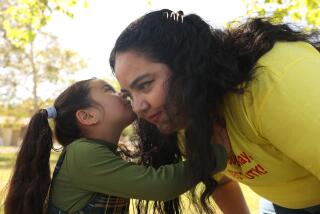Health Teachers in Need of Stricter Guidelines : Pin-prick session exposed Glendale class to needless risk
- Share via
We’re not sure what’s worse: a Glendale teacher directing 10 students to prick their fingers and draw blood with the same needle, or the fact that this exercise was conducted by someone supposedly qualified to teach health and drug abuse prevention to children.
The foolish idea behind a June 8, sixth-grade lesson at Mark Keppel Elementary School was to show students how their blood looks under a microscope. It went horribly awry when the teacher apparently used the same straight pin on 10 children. Quite rightly, each of those children underwent tests for HIV, the virus that causes the deadly and incurable AIDS disease. They were also tested for exposure to hepatitis B and C.
Dr. Shirley Fannin, Los Angeles County director of Disease Control Programs, said these children shared none of the usual risk factors for the diseases, and it was “highly unlikely” that any of the children would have the blood-borne viruses. But the decision by Fannin and her colleagues to recommend testing was still eminently sensible and appropriate.
The low risk shared by this group of children wasn’t the point. What if they hadn’t been “low risk?” Under less fortunate circumstances, disease could have been passed from child to child. And it took alert parents to bring the whole matter to light. The couple’s child casually referred to the classroom exercise later that day. What if no students had mentioned it? Has this happened before?
The potential repercussions are too important to brush aside. Children might have become very ill. Other possibilities are certainly less significant, but important nonetheless. We don’t know any public school system, for example, that could afford the kind of lawsuit that might arise from similar incidents.
The episode should be treated as a wake-up call for the Glendale school district, and for all others.
The baby boomers among us, for example, can recall when classes on health and good hygiene were unenthusiastically led by whomever was on the low rung of the totem poll, such as gym instructors.
School districts now can’t afford such nonchalance. It is time to revisit district guidelines on health and drug abuse prevention instruction. It is time to test the efficacy of the materials used to prepare teachers for such important responsibilities.
In fact, Glendale Unified School District guidelines only allow classes to use human blood when it is obtained through commercially prepared microscope slides. How many other health teachers are unaware of that standard?
How many teachers still believe that you can reuse any straight pin or needle as long as you run a little alcohol over it? Well, health officials say this is a safeguard only if meticulously done so that not even a microscopic trace of blood is left on the pin. The bottom line: Do not share needles or pins of any kind that have been used to draw blood, period.
And we have another reason for bringing so much attention to this incident and the tragedies that might have occurred.
Parents have to remember that most children will spend a large percentage of their formative years with teachers. The children are usually taught to trust those teachers and to follow their instructions. Most children comply.
Later on in life, your children might be confronted by some peer who wants them to try some intravenously administered drug. You’re going to want your children to fall back on every bit of knowledge they have gained about the dangers involved. You’re not going to want them to think that any part of it will be safe, because all persuasive lies are couched in perceived truths.
You’re certainly not going to want them to remember some classroom teacher who indicated that sharing a pin was OK.
More to Read
Sign up for Essential California
The most important California stories and recommendations in your inbox every morning.
You may occasionally receive promotional content from the Los Angeles Times.










